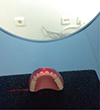1. Johnson GH. Impression materials. In : Craig RG, Powers JM, editors. Restorative dental materials. 11th ed. St. Louis: Elsevier;2001. p. 348–368.
2. Nicholls JI. The measurement of distortion: theoretical considerations. J Prosthet Dent. 1977; 37:578–586.
3. Hamalian TA, Nasr E, Chidiac JJ. Impression materials in fixed prosthodontics: influence of choice on clinical procedure. J Prosthodont. 2011; 20:153–160.
4. Linke BA, Nicholls JI, Faucher RR. Distortion analysis of stone casts made from impression materials. J Prosthet Dent. 1985; 54:794–802.
5. Brosky ME, Major RJ, DeLong R, Hodges JS. Evaluation of dental arch reproduction using three-dimensional optical digitization. J Prosthet Dent. 2003; 90:434–440.
6. Sohmura T, Kojima T, Wakabayashi K, Takahashi J. Use of an ultrahigh-speed laser scanner for constructing three-dimensional shapes of dentition and occlusion. J Prosthet Dent. 2000; 84:345–352.
7. Tarawneh FM, Panos PG, Athanasiou AE. Three-dimensional assessment of dental casts' occlusal surfaces using two impression materials. J Oral Rehabil. 2008; 35:821–826.
8. Tomassetti JJ, Taloumis LJ, Denny JM, Fischer JR Jr. A comparison of 3 computerized Bolton tooth-size analyses with a commonly used method. Angle Orthod. 2001; 71:351–357.
9. Elefteriadis JN, Athanasiou AE. Evaluation of impacted canines by means of computerized tomography. Int J Adult Orthodon Orthognath Surg. 1996; 11:257–264.
10. Phillips RW, Ito BY. Properties of alginates. J Am Dent Assoc. 1951; 43:1–17.
11. Coleman RM, Hembree JH Jr, Weber FN. Dimensional stability of irreversible hydrocolloid impression material. Am J Orthod. 1979; 75:438–446.
12. Anseth KS, Bowman CN, Brannon-Peppas L. Mechanical properties of hydrogels and their experimental determination. Biomaterials. 1996; 17:1647–1657.
13. Dalstra M, Melsen B. From alginate impressions to digital virtual models: accuracy and reproducibility. J Orthod. 2009; 36:36–41.
14. Alcan T, Ceylanoğlu C, Baysal B. The relationship between digital model accuracy and time-dependent deformation of alginate impressions. Angle Orthod. 2009; 79:30–36.
15. Sedda M, Casarotto A, Raustia A, Borracchini A. Effect of storage time on the accuracy of casts made from different irreversible hydrocolloids. J Contemp Dent Pract. 2008; 9:59–66.
16. Henry PJ, Harnist DJ. Dimensional stability and accuracy of rubber impression materials. Aust Dent J. 1974; 19:162–166.
17. Shellhart WC, Lange DW, Kluemper GT, Hicks EP, Kaplan AL. Reliability of the Bolton tooth-size analysis when applied to crowded dentitions. Angle Orthod. 1995; 65:327–334.
18. Champagne M. Reliability of measurements from photocopies of study models. J Clin Orthod. 1992; 26:648–650.
19. Lowey MN. The development of a new method of cephalometric and study cast mensuration with a computer controlled, video image capture system. Part II: Study cast mensuration. Br J Orthod. 1993; 20:315–331.
20. Rossouw PE, Benatar M, Stander I, Wynchank S. A critical comparison of three methods for measuring dental models. J Dent Assoc S Afr. 1991; 46:223–226.
21. Quick DC, Holtan JR, Ross GK. Use of a scanning laser three-dimensional digitizer to evaluate dimensional accuracy of dental impression materials. J Prosthet Dent. 1992; 68:229–235.
22. Yamamoto K, Toshimitsu A, Mikami T, Hayashi S, Harada R, Nakamura S. Optical measurement of dental cast profile and application to analysis of three-dimensional tooth movement in orthodontics. Front Med Biol Eng. 1989; 1:119–130.
23. Santoro M, Galkin S, Teredesai M, Nicolay OF, Cangialosi TJ. Comparison of measurements made on digital and plaster models. Am J Orthod Dentofacial Orthop. 2003; 124:101–105.
24. Zilberman O, Huggare JA, Parikakis KA. Evaluation of the validity of tooth size and arch width measurements using conventional and three-dimensional virtual orthodontic models. Angle Orthod. 2003; 73:301–306.
25. Veenema AC, Katsaros C, Boxum SC, Bronkhorst EM, Kuijpers-Jagtman AM. Index of Complexity, Outcome and Need scored on plaster and digital models. Eur J Orthod. 2009; 31:281–286.
26. Bootvong K, Liu Z, McGrath C, Hägg U, Wong RW, Bendeus M, Yeung S. Virtual model analysis as an alternative approach to plaster model analysis: reliability and validity. Eur J Orthod. 2010; 32:589–595.
27. Yan B, Wang L, Hu QS, Pan L, Yang K, Bao XD. Development and study of three-dimensional CT scanning system for dental cast measurement and analysis. Hua Xi Kou Qiang Yi Xue Za Zhi. 2005; 23:329–331.
28. Kamegawa M, Nakamura M, Tsutsumi S. 3D morphological measurements of dental casts with occlusal relationship using microfocus X-ray CT. Dent Mater J. 2008; 27:549–554.
29. Kamegawa M, Nakamura M, Kitahara K, Ohtomo H, Hasegawa T, Nakakura T, Tsutsumi S. 3D morphological assessment of occlusal treatment by measuring dental casts with a micro-focus X-ray CT. J Oral Rehabil. 2008; 35:382–389.








 PDF
PDF ePub
ePub Citation
Citation Print
Print







 XML Download
XML Download